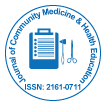Postpartum Diabetes Risk: A Critical Gap in Maternal Healthcare
Received: 07-Mar-2025 / Manuscript No. jcmhe-25-167355 / Editor assigned: 10-Mar-2025 / PreQC No. jcmhe-25-167355 (PQ) / Reviewed: 24-Mar-2025 / QC No. jcmhe-25-167355 (R) / Revised: 31-Mar-2025 / Manuscript No. jcmhe-25-167355 / Published Date: 07-Apr-2025
Description
Hyperglycaemia during pregnancy, encompassing both pre-existing diabetes and Gestational Diabetes Mellitus (GDM), is a growing global concern due to its implications for maternal and fetal health. The physiological, metabolic and psychosocial burden of hyperglycaemia necessitates a comprehensive and multidisciplinary care model that extends beyond pregnancy. While screening, diagnosis and glycaemic management during pregnancy have received significant attention, the continuum of care especially postpartum and long-term follow-up often remains fragmented or underprioritized. A critical commentary on this care pathway is essential to identify the gaps and opportunities for improving outcomes for both mother and child.
During pregnancy, hyperglycaemia presents complex challenges that require careful management to prevent complications such as macrosomia, preeclampsia, neonatal hypoglycaemia, preterm birth and caesarean delivery. Glycaemic control, typically managed through medical nutrition therapy, physical activity and pharmacological interventions when needed, is central to preventing these outcomes. However, optimal care is not solely about glucose monitoring it also includes culturally sensitive dietary counselling, psychosocial support and health literacy interventions that empower women to manage their condition proactively. In many health systems, particularly in low- and middle-income countries, these comprehensive services are inconsistently delivered, leading to variable care quality and missed opportunities for early intervention.
The experience of a high-risk pregnancy due to hyperglycaemia can have significant emotional and psychological impact. Women often experience anxiety, guilt, or fear regarding the health of their baby, the restrictions imposed by treatment regimens and the potential implications for future health. Despite this, psychological support is not routinely integrated into prenatal diabetes care. Mental health screening and referrals should be standard in the care of women with hyperglycaemia in pregnancy, as emotional well-being influences adherence to treatment and long-term health behaviors.
After delivery, the clinical focus often shifts rapidly to the newborn and the mother’s follow-up can become deprioritized. Yet this is a pivotal period for intervention. Women with GDM are at a markedly increased risk of developing type 2 diabetes later in life, with estimates suggesting nearly 50% may convert within 5-10 years postpartum. Furthermore, even those with normoglycaemic pregnancies but with risk factors such as obesity or family history may remain vulnerable. Despite these risks, postpartum glucose testing rates are consistently low worldwide. Contributing factors include poor care coordination, inadequate education about the importance of follow-up, logistical barriers and competing postpartum demands.
There is a pressing need for structured postpartum care pathways that include early screening (typically at 6-12 weeks postpartum), regular follow-up for glycaemic assessment and targeted lifestyle interventions. The importance of continuity of care cannot be overstated maternity care providers must work closely with primary care practitioners and endocrinologists to ensure a seamless transition. Integrating postpartum care into existing maternal and child health visits, such as immunization appointments, can improve follow-up rates and reduce attrition.
Breastfeeding, often underemphasized in clinical consultations, has been associated with improved maternal glucose metabolism and reduced diabetes risk. Women with hyperglycaemia in pregnancy should be supported and encouraged to breastfeed, with attention given to potential challenges such as neonatal hypoglycaemia that may impact early initiation. Lactation support services can play a crucial role in this context, particularly for women who received insulin therapy or experienced complicated deliveries.
Another dimension requiring attention is interconception care the period between pregnancies. Women with a history of hyperglycaemia should receive counseling on family planning, weight management and glucose monitoring to optimize their health prior to future pregnancies. Preconception care remains underutilized, yet it is crucial in preventing recurrence of hyperglycaemia and mitigating risks to both mother and fetus in subsequent pregnancies. Digital health tools and community outreach may offer scalable strategies to engage women during this period, especially those who have disengaged from formal care systems.
Culturally and contextually appropriate care models are especially vital. Women from minority or underserved populations may face additional barriers, including limited access to healthcare, language differences and socioeconomic constraints. These disparities contribute to higher rates of missed postpartum testing and poorer long-term outcomes. A commentary on hyperglycaemia care must address these inequities and advocate for tailored interventions that reflect the diverse needs of patient populations. Community health workers, peer support networks and mobile health technologies are among the promising strategies to bridge these gaps.
In conclusion, the care provided to women during and after a pregnancy complicated by hyperglycaemia must extend beyond glucose control and childbirth. It requires a multifaceted, sustained and patient-centered approach that recognizes the biological, psychological and social dimensions of the condition. Only by addressing gaps in postpartum follow-up, enhancing continuity of care and reducing health disparities can we hope to mitigate the long-term impact of maternal hyperglycaemia. The health of future generations depends on how well we care for mothers today not just during pregnancy, but long after the baby is born.
Citation: Rhodes E. (2025) Postpartum Diabetes Risk: A Critical Gap in Maternal Healthcare. J Community Med Health Educ 15:923.
Copyright: © 2025 Rhodes E. This is an open-access article distributed under the terms of the Creative Commons Attribution License, which permits restricted use, distribution, and reproduction in any medium, provided the original author and source are credited.
Select your language of interest to view the total content in your interested language
Share This Article
Recommended Journals
Open Access Journals
Article Usage
- Total views: 438
- [From(publication date): 0-0 - Nov 18, 2025]
- Breakdown by view type
- HTML page views: 333
- PDF downloads: 105
